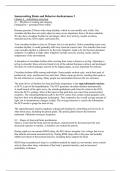Samenvatting Brain and Behavior deeltentamen 2
Chapter 8 – wakefulness and sleep
8.1 – Rhythms of waking and sleeping
Endogenous = generated from within.
Humans generate 24-hour wake-sleep rhythms, which we can modify only a little. Our
circadian rhythm does not easily adjust to more severe departures from a 24-hour schedule.
We also have circadian rhythms in our hunger, thirst, liver activity, insulin secretion,
intestinal activity, DNA repair, and much else.
Your circadian rhythm is close to 24 hours, but it is not perfect. Unless something resets your
circadian rhythm, it would gradually drift away from the correct time. The stimulus that resets
your circadian rhythm is referred to by the term Zeitgeber. Light is by far the most dominant
zeitgeber. In addition to light, other zeitgebers include exercise, arousal, meals, and the
temperature of the environment.
A disruption of circadian rhythms after crossing time zones is known as jet lag. Adjusting to
jet lag is stressful. Stress elevates blood levels of the adrenal hormone cortisol, and prolonged
elevation of cortisol damages neurons in the hippocampus, an area important for memory.
Circadian rhythms differ among individuals. Some people awaken early, reach their peak of
productivity early, and become less alert later. Others warm up slowly, reaching their peak in
the late afternoon or evening. Many people are intermediate between the two extremes.
The main driver of rhythms for sleep and body temperature is the suprachiasmatic nucleus,
or SCN, a part of the hypothalamus. The SCN generates circadian rhythms automatically.
A small branch of the optic nerve, the retinohypothalamic path from the retina to the SCN,
alters the SCN’s settings. Most of the input to that path does not come from normal retinal
receptors. The retinohypothalamic path to the SCN comes from certain retinal ganglion cells
that have their own photopigment melanopsin. They respond to the overall average amount of
light, not to instantaneous changes in light. The average intensity is exactly the information
the SCN needs to gauge the time of day.
The suprachiasmatic nucleus regulates waking and sleeping by controlling activity levels in
other brain areas, including the pineal gland. The pineal gland releases the hormone
melatonin. Melatonin increases sleepiness.
8.2 – Stages of sleep and brain mechanisms
Sleep is a state that the brain actively produces, characterized by decreased activity and
decreased response to stimuli. A stimulus can awaken the person.
During rapid eye movement (REM) sleep, the EEG shows irregular, low-voltage fast waves
that indicate increased neuronal activity. During REM sleep cells in the pons and medulla
inhibit movement of the postural muscles, including those support the head.
REM sleep or paradoxical sleep is a condition marked by rapid eye movements, more cortical
activity than other sleep, relaxation of the body’s postural muscles, and an increased
probability of dreams.
, When you fall asleep, you start in stage 1 and slowly progress to stage 2 and then to slow-
wave sleep, although loud noises or other intrusions can interrupt the progress. After about an
hour of sleep, you begin to cycle back to stage 2 and then REM.
During sleep, enhanced release of GABA limits neuronal activity and blocks the spread of
activation. Because this suppression can be stronger in one brain area than another, it is
possible for part of the brain to be more awake than another.
8.3 - Why sleep? Why REM? Why Dreams?
Sleep serves many functions. During sleep, we rest our muscles and decrease metabolism. We
reorganize synapses and strengthen memories.
A function of sleep is to safe energy. Another function of sleep is improved memory.
REM sleep is associated with activity in several brain areas, including the pons, limbic
system, and parts of the parietal and temporal cortex. Activity decreases in the prefrontal
cortex, the motor cortex, and the primary visual cortex.
Chapter 10 – Reproductive Behavior
10.1 – Sex and Hormones
According to Charles Darwin’s theory of evolution by natural selection, individuals whose
genes help them survive will produce more offspring, and therefore those genes will spread in
the population. A second part of his theory was sexual selection: Genes that increase an
individual’s probability of mating, or probable number of surviving offspring, will also spread
in the population.
From the evolutionary standpoint of spreading, one’s genes, males can succeed by either of
two strategies: be loyal to one woman and devote your energies to helping her and her babies,
or mate with many women and hope that some of them can raise your baby without your help.
In contrast, a women can have no more than one pregnancy per 9 months, regardless of her
number of sex partners. Men potentially have more to gain from multiple sex partners than
women do.
Some people have chromosome patterns that are neither XX nor XY. Turner syndrome is
characterized by an XO pattern – an X chromosome and no (complete) second sex
chromosome. The result is a typical feminine appearance, and almost always self-
identification as female, but ovaries that secrete less than average amounts of sex hormones.
Klinefelter syndrome is characterized by an XXY pattern, or less commonly XXYY or
XXXY. The appearance is masculine, nut most individuals are infertile.
Male and female mammals have the same anatomy during an early stage of prenatal
development. Both have Müllerian ducts (= precursors to female internal structures) and
Wolffian ducts (= precursors to male internal structures), and gonads that look alike. A little
later in biological males, the SRY gene (sex-determining Region on the Y chromosome)
causes those undifferentiated gonads to develop into testes, the sperm-producing organs. The
testes produce androgens (= male-typical hormones) that increase the growth of the testes,
causing them to produce still more androgens. Androgens cause the Wolffian ducts to develop
into seminal vesicles (= structures that store semen) and the vas deferens (= a duct from the
testis into the penis). The testes also produce Müllerian-inhibiting hormone (MIH) that cause
the Müllerian ducts to degenerate. The result is a penis and scrotum.




